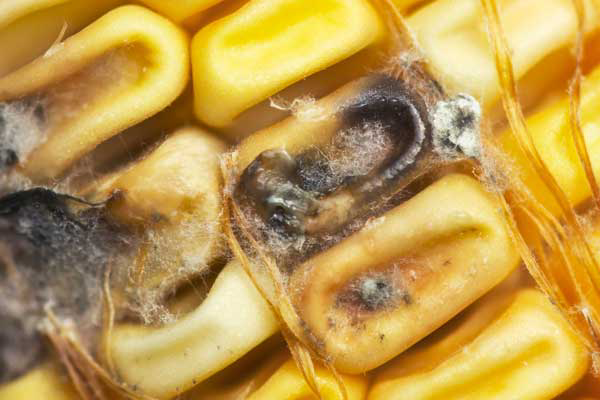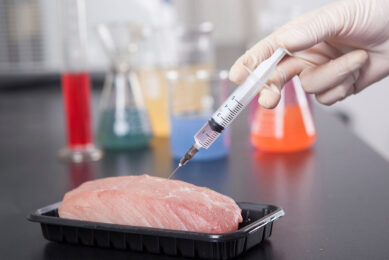Varied effect of mycotoxin binders

Mycotoxin binders are a great tool to combat the negative effects of the toxins. However, not all binders work the same and some products also tend to bind nutrients such as vitamins. A French trial with roosters showed that some binders may not have this undesirous binding effect.
By Elise Nacer-Khodja, T5X product manager, NEOVIA InVivo, France
The prevention of mycotoxins is an essential part of the biosecurity plan in feed mills and on farms. Mycotoxins binders are often used for this, but these products come in different shapes and can work in a different way. Binders can be called ‘simple binders’, when they only contain a binding component as clay for example. They can also be called ‘complex binders’, when they contain other additional elements that can work in synergy to reduce detrimental effects of mycotoxins in animals.
The objective of binders is to avoid the transfer of toxins through the digestive barrier into the blood of the animals, by sequestering it, and eliminate it in the faeces. This sounds simple but the mechanism of mycotoxin binding is complex. Binding can be based on ionic interactions between the mycotoxin and the clay. This reaction is generated because clays, such as bentonite, are layered aluminosilicates, composed of tetrahedral silicon sheets and octahedral aluminium sheets. The negatively charged octahedral sheet is fixed to the two tetrahedral sheets by countervailing oxygen cations (Figure 1 and 2). Hence, the positively charged mycotoxins like aflatoxins can be fixed to clay sheets by exchanging a cation with it. Also other physical characteristics, like specific surface, are involved into the binding capacity of clay based mycotoxin binders.
Negative side effects
Consequently each binder has its own specific binding capacity that can vary a lot according to its origin and treatments (chemical, physical or thermic). This means that two clays, even from the same family like bentonites, can have a different efficacy and be more or less selective towards mycotoxins. Due to this sequestering mode of action, many people are reluctant to use such products. The European Union allows a maximum incorporation of clay of 2% in feed, in order to bind aflatoxin B1, (Implementing regulation n°1060/2013 concerning the use of bentonite as additive in feed of all animals’ species). But even at lower quantities, the risk of binding nutrients exists. This undesirable binding can lower the efficiency against mycotoxins, and reduce the availability of essential nutrients for growth and production. EFSA also warned for this in its first scientific opinion on the safety and efficacy of bentonite as feed additive. EFSA said that there is potential binding of manganese, an essential trace element, when bentonite is used at a dosage higher than 0.5% in the feed (European Authority for Food Safety journal 2011;9 (2):2007). In 2010, EFSA published a statement (EFSA Journal 2010. 8 (7): 1693) on the establishment of guidelines for the assessment of additives, from the functional group ‘substances for reduction of the contamination of feed by mycotoxins’. In this statement, EFSA recommends to measure the apparent digestibility of crude proteins, vitamin B1, vitamin A and a coccidiostat on broilers in the feed when it is supplemented by a mycotoxin binder, to prove its safety towards potential nutrients and medical substances binding.
Apart from binding nutrients, clays can also alter the efficacy of medicinal substances in the feed, such as coccidiostats. For example, Gray SJ et al. showed that a level of 0.5% of bentonite in the diet can reduce the efficacy of monensin and salynomycin in chicks. Small protein molecules that are positively charged can also be bound into the interlayer of montmorillonite through the cation exchange.
Rooster trial
In order to prove the safety of the use of clay regarding nutrients and medicinal substances availability, a digestibility test was done with 48 roosters on InVivo’s experimental station in Saint-Nolff (France). Two different diets were compared: a control diet composed of a 100% standard broiler feed without any mycotoxin binder, and a second diet composed of a 99% standard broiler feed + 1% clay (a mix of bentonite and of montmorillonite, used in T5X range, with a level of 10 kg*/tonne of feed). The digestibility of four elements was measured: vitamin B1 (thiamine – hydrosoluble), vitamin A (liposoluble), crude proteins and narasin (coccidiostatic). For each diet, 12 intact adult roosters were used to measure the digestibility of vitamin A, vitamin B1 and narasin. To avoid caecal fermentation and uric acid secretion and so have accurate results (Jaillier V et al., 2003), 12 caecectomised adult roosters were used to measure the crude proteins digestibility. All animals, located in individual cages, were forced-fed with no access to feed for the 24 hours before the trial and for the 48 hours after the gavage.
After collecting the faeces, apparent digestibility of each component was calculated following this formula: Apparent digestibility = (Quantity of nutrient ingested – quantity of nutrient in dried faeces) / Quantity of nutrient ingested.
Attention to composition
After faeces drying and analysis, no difference could be observed between the two different diets, with or without mycotoxin binder (Table 1). In this trial, the apparent digestibilities of vitamin B1 and vitamin A, crude proteins and the anticoccidial narasin measured in the animals were not affected by the addition of the clay used by NEOVIA (InVivo) in its range of mycotoxin binder products, in comparison to a control group of rooster that did not consume any mycotoxin binder. Nevertheless, as seen before, clay characteristics can vary a lot according to their origin and treatments (chemical, physical or thermic), so no general conclusion can be made on all types of clays and such a trial needs to be done for each ingredient that is prone to binding.
Moreover, all mycotoxin binders are not only composed of clays, and some binding agents such as charcoals may sometimes be used for their good binding properties, with no regards to their non-specific binding. Because mycotoxin binders are used very frequently and often part of the total mycotoxin prevention plan, attention must be paid to their composition. Only then, the highest quality and nutritional values can be guaranteed, preserving the medicines’ efficacy and to optimise the genetic potential of the animals.
[Source: Managing mycotoxins, 2014]
References are available on request.
* The maximum dosage recommended by Neovia (part of InVivo group).
Join 26,000+ subscribers
Subscribe to our newsletter to stay updated about all the need-to-know content in the feed sector, three times a week. Beheer
Beheer









 WP Admin
WP Admin  Bewerk bericht
Bewerk bericht